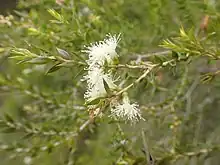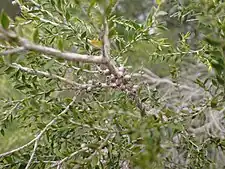Melaleuca squamophloia
Melaleuca squamophloia is a plant in the myrtle family, Myrtaceae and is endemic to the black soil plains of south eastern Queensland in Australia. Like its close relative Melaleuca styphelioides, it is a small, erect tree with prickly leaves and spikes of cream or white flowers but its bark is hard rather than papery and the leaves have fewer veins than that species.
| Melaleuca squamophloia | |
|---|---|
 | |
| Scientific classification | |
| Kingdom: | Plantae |
| Clade: | Tracheophytes |
| Clade: | Angiosperms |
| Clade: | Eudicots |
| Clade: | Rosids |
| Order: | Myrtales |
| Family: | Myrtaceae |
| Genus: | Melaleuca |
| Species: | M. squamophloia |
| Binomial name | |
| Melaleuca squamophloia | |
| Synonyms[1] | |
|
Melaleuca styphelioides var. squamophloia Byrnes | |
Description
Melaleuca squamophloia is a shrub or small tree growing to 7 m (20 ft) high, with hard, scaly or fibrous bark. Its leaves are arranged alternately, 4–12 mm (0.2–0.5 in) long, 1.6–3.5 mm (0.06–0.1 in) wide, narrow egg-shaped with the end tapering to a sharp, prickly point and with 3 to 15 veins.[2][3]


The flowers are white or cream-coloured and are arranged in spikes on the ends of branches which continue to grow after flowering and on the sides of the branches. Each spike contains 5 to 16 individual flowers and is up to 20 mm (0.8 in) in diameter. The petals are 1.5–1.8 mm (0.06–0.07 in) long and fall off as the flower opens or soon after. There are five bundles of stamens around the flower, each with 15 to 20 stamens. Flowering occurs in spring and from April to June, and is followed by fruit which are woody, almost spherical capsules, 2.5–3.5 mm (0.098–0.14 in) long.[2][3]
Taxonomy and naming
Melaleuca squamophloia was first named in 1997 by Lyndley Craven and Bryan Barlow in Novon.[4][5] It was first formally described in 1984 as Melaleuca styphelioides var. squamophloia by Norman Byrnes.[6] The specific epithet (squamophloia) is from the Latin word squama meaning "scale"[7]: 746 and the Ancient Greek word φλοιός (phloiós) meaning “bark”[7]: 123 referring to the bark of this species which is hard and scaly.[2]
Distribution and habitat
This melaleuca occurs on the black soil plains in and between the Miles, Jandowae and Tara districts of south east Queensland. It grows in woodland and scrubland in clay and clay loam.[2]
References
- "Melaleuca squamophloia". Plants of the World Online. Retrieved 8 September 2021.
- Brophy, Joseph J.; Craven, Lyndley A.; Doran, John C. (2013). Melaleucas : their botany, essential oils and uses. Canberra: Australian Centre for International Agricultural Research. p. 337. ISBN 9781922137517.
- Holliday, Ivan (2004). Melaleucas : a field and garden guide (2nd ed.). Frenchs Forest, N.S.W.: Reed New Holland Publishers. p. 274. ISBN 1876334983.
- Craven, L. A.; Barlow, B. A. (1997). "New Taxa and New Combinations in Melaleuca (Myrtaceae)". Novon. 7 (2): 118. doi:10.2307/3392182. Retrieved 9 June 2015.
- "Melaleuca squamophloia". APNI. Retrieved 9 June 2015.
- "Melaleuca styphelioides var. squamophloia". APNI. Retrieved 9 June 2015.
- Brown, Roland Wilbur (1956). The Composition of Scientific Words. Washington, D.C.: Smithsonian Institution Press.
